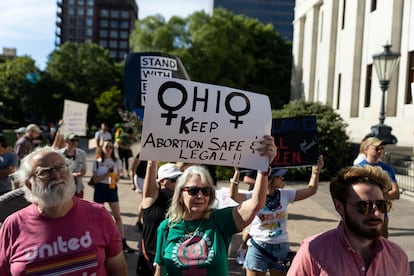Ohio rejects Republican Party measure seeking to curb access to abortion
A referendum that would have made it more difficult to protect reproductive rights in the state constitution has been knocked down by voters in the state


Ohio has taken a key step in the defense of the right to abortion in the United States. On Tuesday, the voters of this bellwether state — which plays a pivotal role in every vote in the United States — rejected by a resounding majority a measure proposed by the Republican Party that would have made it much more difficult to amend the local constitution and enshrine the right to abortion.
At first glance, the measure, known as Issue 1, appeared to be a simple legislative procedure, a very local and slightly abstruse proposal. But it has become a touchstone for how willing citizens are to defend access to abortion, a year after the Supreme Court struck down Roe v. Wade, the landmark ruling which established the constitutional right to abortion in 1973.
More than 60% of voters voted against Issue 1, clear evidence that the proposal was far from popular. The result also revealed to what extent the right to abortion continues to mobilize American voters a year after the Supreme Court ruling. It’s a trend that both the Republican Party and the Democrats will have to take into account ahead of the presidential elections in November 2024. In the midterm elections of 2022, support for reproductive rights played a key role in the outcome: the Democrats — who had based much of their campaign on defending access to abortion — obtained better results than expected and were able to retain control of the Senate.
Issue 1 proposed raising the minimum percentage of votes to pass any amendment to the Ohio constitution to 60%, instead of the current 50%. The Republicans, who hold the majority in the state legislature, argued that the measure was needed to protect basic law against possible interference by foreign pressure groups.
But since it was proposed, Issue 1 has been seen as an attempt to stop an amendment that seeks to guarantee the right to abortion in Ohio. Last year, the state banned abortions after six weeks, when many women do not even know they are pregnant.
The amendment, which will be voted on in November, was presented by a citizen initiative. It proposes to enshrine the “fundamental right to reproductive freedom” within “reasonable limits.” Polls indicate that 58% of voters support the measure. In other words, it could easily be approved by a simple majority, but would fall short of the supermajority proposed by Issue 1. Now, with Issue 1 struck down, the upcoming months are shaping up to be a fierce battle between supporters and opponents of the proposal to enshrine reproductive rights in the state constitution.
U.S. President Joe Biden welcomed the results of Tuesday’s vote, which had generated great interest across the country. “This measure was a blatant attempt to weaken voters’ voices and further erode the freedom of women to make their own health care decisions. Ohioans spoke loud and clear, and tonight democracy won.”
The One Person One Vote campaign, a coalition of organizations that had brought together opposition to Issue 1, was jubilant. “Tonight is a major victory for democracy in Ohio,” said spokesman Dennis Willard at the organization’s party to follow the count. “The majority still rules in Ohio.”
In contrast, the Susan B Anthony Pro-Life America association, which is opposed to abortion, described the result as “a sad day for Ohio.” It also complained that funds from other states were used to support the campaign against Issue 1.
The vote had sparked great interest within Ohio and beyond. In the middle of August, when many families go on vacation before school resumes, more than 700,000 people had cast early ballots, in person or by mail. This was nearly double the number of any primary in the state. Before the last day of voting, turnout in Ohio — which is increasingly leaning to the Republican Party at a national level — was especially high in Democratic-leaning cities such as Cleveland, Columbus and Cincinnati.
The result has drawn a sigh of relief from reproductive rights organizations across the United States. If successful, Issue 1 could have set a precedent for other conservative states to follow.
The Supreme Court ruling last year gives states the power to establish their own laws on abortion. Since then, at least 25 states have imposed limits, or effectively prohibited, access to abortion. In others, including conservative states such as Kansas and Kentucky, voters have rejected attempts to impose restrictions in referendums. But, in a country where reproductive rights remain deeply divisive, the result of the referendums have not reached 60%.
Sign up for our weekly newsletter to get more English-language news coverage from EL PAÍS USA Edition
Tu suscripción se está usando en otro dispositivo
¿Quieres añadir otro usuario a tu suscripción?
Si continúas leyendo en este dispositivo, no se podrá leer en el otro.
FlechaTu suscripción se está usando en otro dispositivo y solo puedes acceder a EL PAÍS desde un dispositivo a la vez.
Si quieres compartir tu cuenta, cambia tu suscripción a la modalidad Premium, así podrás añadir otro usuario. Cada uno accederá con su propia cuenta de email, lo que os permitirá personalizar vuestra experiencia en EL PAÍS.
¿Tienes una suscripción de empresa? Accede aquí para contratar más cuentas.
En el caso de no saber quién está usando tu cuenta, te recomendamos cambiar tu contraseña aquí.
Si decides continuar compartiendo tu cuenta, este mensaje se mostrará en tu dispositivo y en el de la otra persona que está usando tu cuenta de forma indefinida, afectando a tu experiencia de lectura. Puedes consultar aquí los términos y condiciones de la suscripción digital.
More information
Archived In
Últimas noticias
Most viewed
- Reinhard Genzel, Nobel laureate in physics: ‘One-minute videos will never give you the truth’
- Oona Chaplin: ‘I told James Cameron that I was living in a treehouse and starting a permaculture project with a friend’
- Pablo Escobar’s hippos: A serious environmental problem, 40 years on
- Why we lost the habit of sleeping in two segments and how that changed our sense of time
- Chevy Chase, the beloved comedian who was a monster off camera: ‘Not everyone hated him, just the people who’ve worked with him’










































